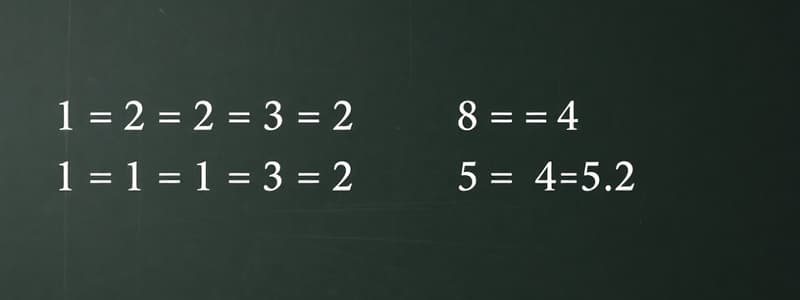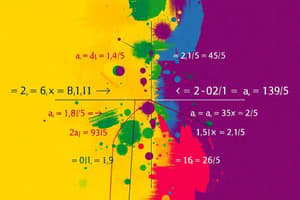Podcast
Questions and Answers
A cafe owner is debuting a new menu and wants to predict its success. Which concept will help them?
A cafe owner is debuting a new menu and wants to predict its success. Which concept will help them?
- Probability
- Geometry (correct)
- Statistics
- Calculus
The addition rule can be used to calculate the probability of mutually exclusive events.
The addition rule can be used to calculate the probability of mutually exclusive events.
True (A)
If the probability of an event occurring is 0.35, what is the probability of the event not occurring, based on the complement rule?
If the probability of an event occurring is 0.35, what is the probability of the event not occurring, based on the complement rule?
0.65
The probability of rolling a 4 or a 6 on a fair six-sided die is ______.
The probability of rolling a 4 or a 6 on a fair six-sided die is ______.
Match the probability rule with its correct application
Match the probability rule with its correct application
In probability theory, what does 'mutually exclusive' mean?
In probability theory, what does 'mutually exclusive' mean?
Joint probability of rolling a four and a six on a fair six-sided die is greater than 0.
Joint probability of rolling a four and a six on a fair six-sided die is greater than 0.
What is probability of S, where S is the probability that a graduate student will purchase off the student menu variable, and the probability of S is 0.18, complement of S?
What is probability of S, where S is the probability that a graduate student will purchase off the student menu variable, and the probability of S is 0.18, complement of S?
According to the ______ rule, you can find the probability that a graduate student will not purchase an item.
According to the ______ rule, you can find the probability that a graduate student will not purchase an item.
Probabilities of simple events must:
Probabilities of simple events must:
Flashcards
Complement Rule
Complement Rule
The probability that an event does NOT occur. It is calculated by subtracting the probability of the event occurring from 1.
Addition Rule
Addition Rule
It says the probability of either of two events occurring is the sum of their individual probabilities minus their joint probability (probability of both happening).
Mutually Exclusive Events
Mutually Exclusive Events
Events that cannot both occur at the same time. Rolling a 4 and a 6 on a single die roll are mutually exclusive.
Joint probability
Joint probability
Signup and view all the flashcards
Study Notes
- Probability can help predict events.
- Understanding probability is useful when introducing a product to market.
Complement Rule
- It can be used to determine the probability that a randomly selected graduate student will not purchase a menu item.
- If the probability of a graduate student purchasing a menu item (event S) is 0.18
- To find the probability of the complement of S subtract 0.18 from 1.
- Therefore, the probability that they will not purchase is 0.82.
Addition Rule
- Used to calculate the probability of rolling a four or a six on a die.
- Can be calculated by adding the probability of rolling a four to the probability of rolling a six, then subtracting the probability of rolling both.
- The probability of rolling a four is 1/6.
- The probability of rolling a six is 1/6.
- Rolling a four and rolling a six are mutually exclusive events, you can only roll one die.
- Rolling a four and six together is 0
- This means the probability of rolling a four or a six is 2/6 (or 1/3).
- Complement and addition rules are straightforward and powerful.
- These rules can be applied beyond basic statistics.
Studying That Suits You
Use AI to generate personalized quizzes and flashcards to suit your learning preferences.




